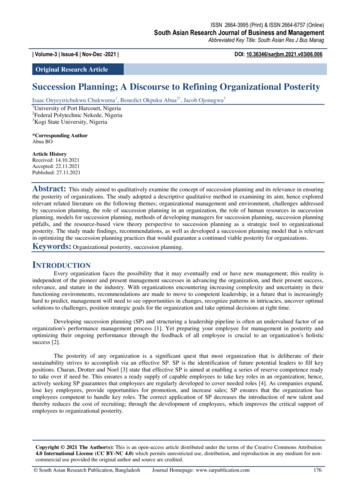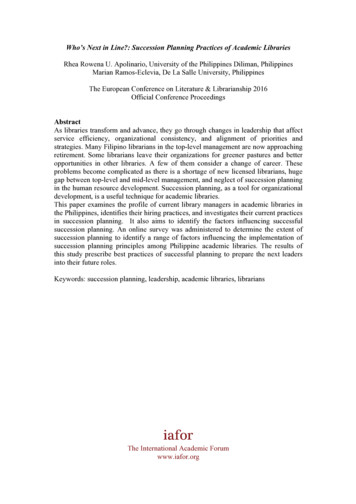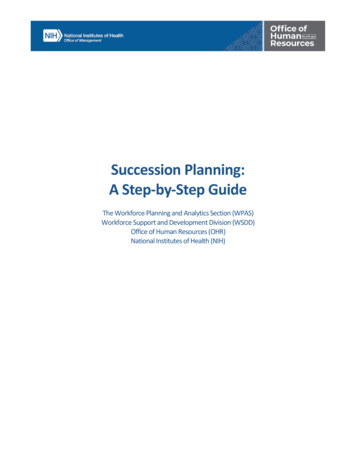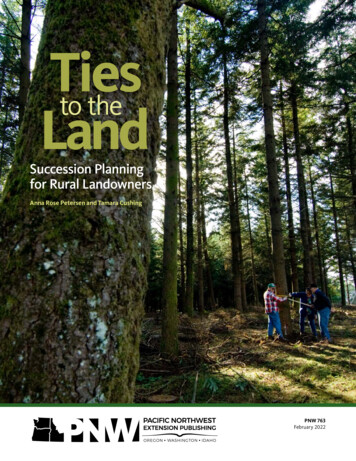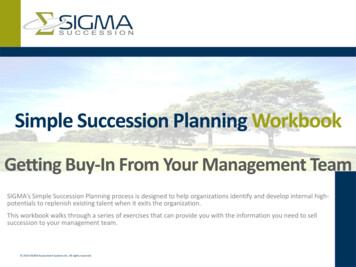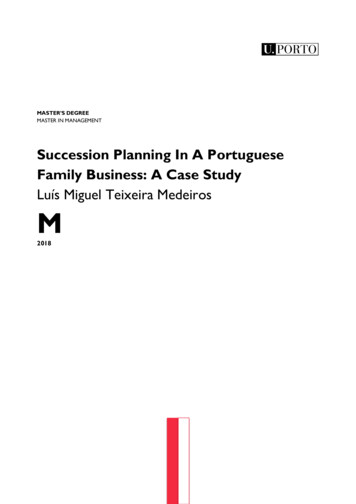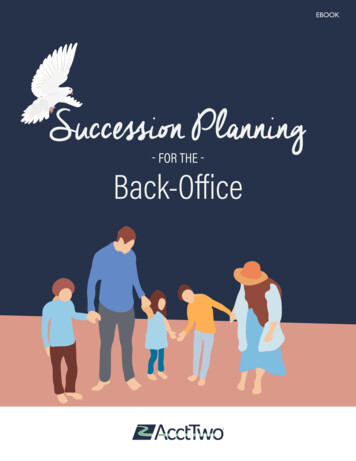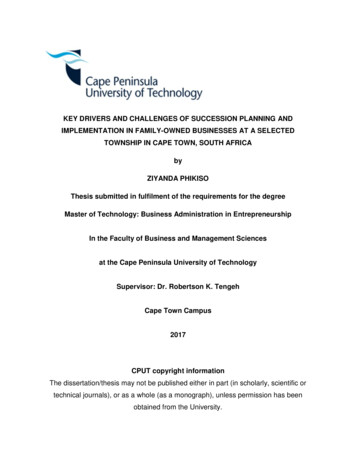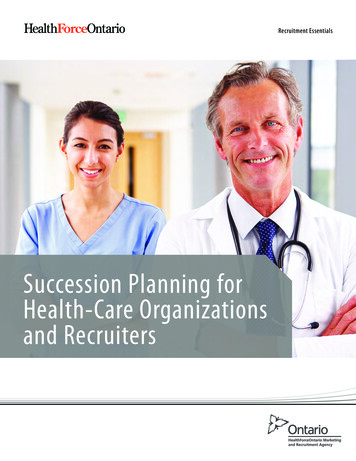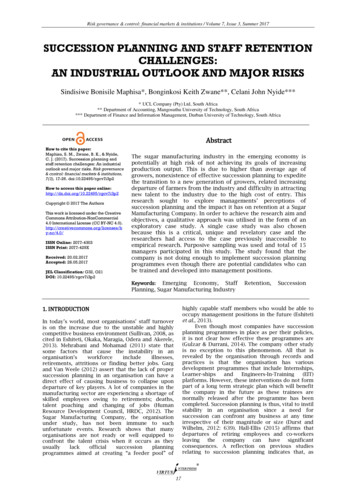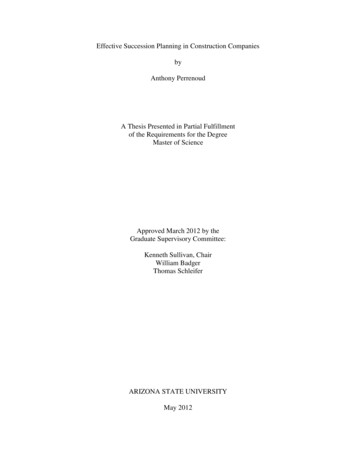
Transcription
Effective Succession Planning in Construction CompaniesbyAnthony PerrenoudA Thesis Presented in Partial Fulfillmentof the Requirements for the DegreeMaster of ScienceApproved March 2012 by theGraduate Supervisory Committee:Kenneth Sullivan, ChairWilliam BadgerThomas SchleiferARIZONA STATE UNIVERSITYMay 2012
ABSTRACTHuman resources have always been the most critical factor in theconstruction industry, and now, with a historic generation entering the age ofretirement, the construction industry needs to place greater effort in preparing forthe succession of their most important of human resource, their leaders. Asignificant body of research has shown that succession planning minimizes thenegative effects that come with leadership transition; however, little research hasfocused specifically on the construction industry. The majority of constructioncompanies are family owned or have small pools of potential successors, whichmake them more susceptible to the negative impacts that occur with poor planningfor succession. The objective of this research focuses on developing amethodology that will assist construction companies plan and prepare for aleadership transition. Data is gathered from case studies of twelve constructioncompanies that have recently experienced leadership succession. The data isanalyzed for practices and characteristics that correlate to successful leadershiptransitions. Through the findings in the literature review and data analysis of thecase studies, the research successfully achieves the objective of developing apotential methodology for increasing the effectiveness of succession planning in aconstruction company.i
ACKNOWLEDGMENTSFirst I want to dedicate this thesis to my wife and thank her for her love,patience, and support. Kellie makes me a stronger, smarter and better person.I would like to thank Dr. Kenneth Sullivan for his amazing guidance withmy research, his foresight and knowledge has been highly influential to thesuccess of my research.I am greatly appreciative to Dr. Tom Schleifer and Dr. William Badger forproviding a foundation of knowledge in the beginning of my research that I wasable to build upon.Also I give thanks to all of the contractors that donated their time and theirstories to provide the case studies in this thesis. I hope that through their sharedexperiences industry will be better prepared for leadership transition.Lastly, I want to thank my family who has always supported me in my lifepursuits.ii
TABLE OF CONTENTSPageLIST OF TABLES. viLIST OF FIGURES . viiiCHAPTER1 INTRODUCTION . 1Introduction . 1Succession Planning . 2Challenges in Succession Planning . 3Succession Planning in the Construction Industry . 4Problem Statement . 5Research Objective . 5Research Methodology Summary . 6Research Scope and Limitations . 6Summary of Thesis . 72 LITERATURE REVIEW . 8Introduction . 8Succession Research History. 8Areas of Succession Research Focus . 9Family and Non-Family Owned Differances. 11Resistance to Succession Planning. 12Critical Review of Recommended Practices. 15iii
CHAPTERPageTop Ten Recommended Practices in Succession Planning . 16Lack of Construction Industry Research . 22Comparison of Recommended Practices . 25Conclusion . 263 METHODOLOGY . 28Introduction . 28Data Collection . 28Data Analysis . 30Summary . 334 DATA COLLECTION . 34Introduction . 34Expert Interview . 34Case Study 1 . 39Case Study 2 . 42Case Study 3 . 45Case Study 4 . 47Case Study 5 . 49Case Study 6 . 52Case Study 7 . 54Case Study 8 . 57Case Study 9 . 60Case Study 10 . 63iv
CHAPTERPageCase Study 11 . 68Case Study 12 . 705 DATA ANALYSIS . 74Introduction . 74Company Characteristics . 74Succession Timeline . 78Succession Planning . 77Management Transition . 83Ownership Transition . 85Successor Training and Mentoring . 88Transition . 89Recommended Practices . 92Level of Success . 966 CONCLUSION . 100Summary . 100Recommendation for Future Research . 103Conclusion . 103REFERENCES . 105APPENDIXARESEARCH PARTICIPANT EMAIL INVITATION. 110BINTERVIEW QUESTIONS . 112v
LIST OF TABLESTABLE2.1PageStudies in Kesner and Sebora’s Critical Review of ExecutiveSuccession Research by Subcategory and Decade . 92.2Top Ten Recommended Practices for Succession Planning. 152.3Articles Relating to Succession Planning Found in TargetedJournals . .242.4Construction Articles Found by Year Published . 242.5Comparison of Recommended Practices Found in Literature . 263.1Level of Success Analysis Questions with Quantitative Score . 334.1Three Filters for Evaluating Executives Sum and Substance . 375.1Company Ownership Type before the Leadership Transition . 785.2Leading Causes for a Predecessor to Begin Planning Retirement. 805.3Quality of Plan Analysis . 815.4Leading Causes for a Predecessor to Begin Planning Retirement thatScored Lower than Fifty Percent on Their Quality of Plan . 825.5Leading Causes for a Predecessor to Begin Planning Retirement thatScored Higher than Fifty Percent on Their Quality of Plan . 825.6Ratio of Family Companies with Interested Children Working InsideCompany . 835.7Previous Job Titles of Non-Children Successors . 845.8Company Ownership Type after the Leadership Transition . 86vi
TABLEPage5.9Method of Ownership Transfer . 875.10Method of Selling Ownership. 885.11Ratio of Predecessors that Disengaged after Transition . 905.12Responsibilities of Predecessors after Transition. 905.13Disagreement between Predecessors and Successors afterTransition . 915.14Ratio of Companies that Lost Senior Management the Year afterTransition . 915.15 Reasons that Senior Management Left the Year after Transition . 925.16 Top Ten Recommended Practices Case Study Analysis . 935.17 Level of Success Analysis . 97vii
LIST OF FIGURESFIGUREPage5.1Geographical Locations of Case Studies . 755.2Leadership Transition to Age of Company . 765.3Geographical Average Yearly Revenue to Number of Employees inEleven Case Studies . 775.4Leadership Transition Time Periods. 795.5Correlation of Recommended practices to Quality of Plan . 955.6Correlation of Level of Success to Quality of Plan. 985.7Correlation of Level of Success to Recommended practices . 99viii
Chapter 1INTRODUCTIONIntroductionPeople serve as the most vital resource for many industries, and theconstruction industry is no exception. The construction industry relies onindividuals from the bottom up but none are more important than the executivesthat establish and guide their companies (Yankov & Kleiner, 2001). These criticalindividual leaders are a scarce resource in today’s construction industry,development of these leadership skills requires time, planning, and preparation(Toor & Ofori, 2008). Human resources such as potential leaders are even limitedmore in small family companies that make up the majority of the constructioncompanies (Schrader, 2006). Many of these family companies today have anaging generation on the brink of retirement that has various levels of leadershipresponsibilities (Chavez, 2011). The succession of these leaders is an inevitablechange that will impact many construction companies in the near future (Miller,1993), proper succession planning is critical for their survival. He et al (2010)shows that an immediate impact most often negative is involved with leadershiptransition in some way or another. Only 30 percent of family businesses surviveleadership transition from the first generation to the second generation, evenfewer of the companies survive to the third generation (Beckhard & Dyer, 1983).A construction company can proactively prepare themselves for their leadershiptransition and minimize the negative impacts that correlate with leadership1
change, the research in this thesis looked to find these methods for effectivesuccession planning in construction companies.Succession PlanningSambrook (2005) defined succession planning as “the attempt to plan forthe right number and quality of managers and key-skilled employees to coverretirement, death, serious illness or promotion, and any new positions which maybe created in future organization plans”. Even though today’s definition ofsuccession planning includes the organization’s attempt to prepare for transitionof all management positions (Rothwell, 2010), the focus of this thesis will besolely towards the succession and preparation of the top position in a company.The typical succession plan includes four phases (Sobol, et al, 2003):1. Understand the vision of the company’s future and needs2. Analyze and select the best candidate3. Prepare a development plan for the candidate4. Transition individuals into new positionAlthough these basic steps summarize succession planning in four steps, eachcompany’s plan will be different in various degrees of complexities to minimizethe impact of transition. Hadelman et al (2005) stated “Succession Plans are likefingerprints - no two are alike, and they leave an impression on everything theytouch.” Research in succession planning has developed an abundant number ofstudies to understand the challenges that organizations have with successionplanning.2
Challenges in Succession PlanningAlthough research has established the importance of proper successionplanning (Leibman, Bruer & Maki, 1996), many firms continue to operate withouta formal succession plan. A 2004 survey of 711 human resource managers foundthat although 80 percent of the managers believed that succession planning wascritical, less than half of their companies had a succession plan in progress(Taylor & McGraw, 2004). Two other surveys found that few organizations haveproper succession plans prepared to replace their leadership, a 2009 survey byRHR International and Chief Executive magazine found 40 percent of CEO’swere not prepared for succession (Cairns, 2011), a 2011 study found that only 35percent of thirteen hundred CEO executives had a succession plan (SFGate,2011). The three studies show that half of companies are not prepared or are notcurrently preparing for leadership succession. Research has shown that executivesare reluctant to plan for succession for multiple reasons such as: fear ofretirement, fear of the unknown, fear of losing control, fear of death, lack ofinterests outside of work, and a strong sense of personal attachment to thecompany (Ibrahim, et al 2001; Handler & Kram, 1988).Another challenge in succession planning comes with analyzing andselecting the correct successor for the company. Rothwell (2010) has stated thatanalyzing, selecting and developing the right candidate are a large part insuccession planning if these steps are not made the likelihood that leadershiptransition will be successful decreases. The selection of an unprepared orinappropriate successor can create damaging impacts after leadership transition.3
Dalton (2006), states that 40 percent of CEO’s fail in their first 18 months. Thechallenges and difficulties of planning for succession should not be overlooked bya company or the owners if they desire the company’s continuous success (He etal, 2010).Succession Planning in the Construction IndustryPast research has established the benefits of planning for succession butthere is little research available to understand the unique attributes of leadershiptransition in construction companies. The researcher’s literature review of themost prominent construction research journals provided little information that aconstruction company could apply for planning succession. Although humanresources are the most critical resources in the construction industry (Yankov &Kleiner, 2001), research for maintaining and replacing these individuals hasprovided little assistance for the industry.These human resources are more scarcely found in small familycompanies that make up the majority of the construction companies (Schrader,2006). The smaller pool of individuals makes it more difficult to find a qualifiedleader, more likely the individuals selected as a successor in a company willrequire training and preparation to become a strong leader in the constructionindustry (Toor & Ofori, 2008).Another challenge found with succession planning with family ownedconstruction companies is how to transfer ownership to the new successor. If noheir apparent is available for a family owned business, selection of a successorwill also include how ownership will transfer to the new successor. This transfer4
of ownership proves to be difficult for many construction owners. Kirschner andUngashick (2005), state that construction owners struggle with understandingtheir options for selling their company, how they will receive the estimated valueof the company, and when planning should begin.Problem StatementThe transition of leadership is a critical point in a company’s existence andmany changes come from succession that not only effect the managementdirections of the company but often will change the ownership of the company(Schleifer & Badger, 2011). Planning for succession has been credited forminimizing the impacts that come from leadership transition in companies (Behnet al, 2005). Despite the growing interest of research done with leadershipsuccession since the late fifties, little research is available to the constructionindustry on what drives effective succession planning in their industry (Kesner &Sebora, 1994). This lack of research creates a need for relevant studies that willassist a construction company effectively plan for succession of their executiveleadership.Research ObjectiveThe objective of this research is to develop a methodology that aconstruction company can follow to develop a quality succession plan. Includedin the objective is to see the trends in construction leadership transitions anddevelop a typical succession timeline that can assist planning through the most5
important phases of succession. The study will analyze findings to identify bestmethods for planning succession and prepare the predecessor and the successorfor the transition.Research Methodology SummaryThe methodology for achieving the researcher’s objective began withcapturing data in a personal interview with a professional consultant that hasassisted various construction companies with succession planning. The researcherwas able to captured data through personal interviews with twelve executives ofconstruction companies that have recently experienced leadership transition. Theresearcher performed an analysis of the data collected from these twelveconstruction companies that varied in size, geographical location, ownership type,and age. The executive transitions in these twelve case studies were evaluated forsuccess levels and analyzed for factors that lead to their success. These factorswere used to develop a methodology that a construction company could use toplan and prepare for succession.Research Scope and LimitationsIn order to collect the in these case studies an invitation to participate inthe research was sent to members of the National Electrical ContractorsAssociation (NECA), the largest electrical contractors association in the UnitedStates. A key assumption is that the electrical contractors interviewed provided asufficient reflection of all trades included in the construction industry, this is alsoa limitation to the research data. Because the case studies were collected fromvolunteering participants it limited the research to companies that were willing to6
share their experiences with succession, an assumption is made from theresearcher that the majority of those that volunteered to interview had experienceda fairly positive succession.Summary of ThesisThis thesis documents the research and development of a methodology forconstruction companies to follow to effectively plan for succession of theexecutive leaders of the company. The summary of the thesis is as follows:Chapter 2 presents a literature review of research conducted on executivesuccession, planning for succession, recommended practices found insuccession research, and succession research in the construction industry.Chapter 3 describes the methodology to collect the data from the twelvecase studies presented in the thesis. This chapter also includes the dataanalyses that were conducted with the data collected from the case studies.Chapter 4 presents the data collected in the personal interviews ofsuccession planning experts and the twelve construction executives thatrecently experienced leadership transition.Chapter 5 describes the results of the data analysis of the twelve casestudies. Analysis of data include: correlation between successful factorsfound in succession practices, an average succession timeline, and trendsin typical construction leadership transitions.Chapter 6 concludes the findings in the data analysis and finalizes theresearcher’s methodology for construction companies to effectively planfor succession.7
Chapter 2LITERATURE REVIEWIntroductionThis chapter covers the literature review of the existing research found insuccession planning, it starts with the history of the past research that can befound on succession and how it has developed in the past six decades. It coversthe distinguishing factors that influence succession and how it’s impacteddepending on the characteristics of the company. Best practices are found in acritical review of the existing research in succession a brief explanation of thebest practices is also included. The chapter reviews the lack of successionresearch found specifically in the construction industry’s journal publications. Acomparison of the research in the different industries is also presented todemonstrate the lack of research available to the construction industry withsuccession planning.Succession Research HistoryResearch in planning for succession dates as far back as the earlytwentieth century with Henri Fayol’s 14 principles of management published in1916. Fayol’s (1949) twelfth principle acknowledges the importance ofdeveloping and retaining key employees with his principle of “Stability of TenurePersonnel”. But, it was not until the late 1950’s and early 1960’s that research inSuccession Planning developed from mere case studies to being tested and studiedfor hypothesis confirmation (Kesner & Sebora, 1994). Oscar Grusky isacknowledged for his early recognition of the lack of research in the field, his8
development of research methods to test hypotheses within succession hasbecome the base for researchers to follow (Grusky, 1961; 1963). Grusky’s twobasic reasons for the need to study succession were: “(1) Administrativesuccession always leads to organizational instability, and (2) it is a phenomenonthat all organizations must cope with (1960). “Walter Mahler (1980) was the first to recognize the advantages ofsuccession planning to company’s performance and encouraged companies topreplan for transition. The research continued to develop approaches and studiesin succession planning and has focused on various impacts of succession such as:company size, type, industry, internal vs. external candidates, methodologies,psychological characteristics with succession, and more (Kesner & Sebora, 1994).Areas of Succession Research FocusKesner and Sebora’s (1994) critical review shows the variety of researchthat has been done in succession, Table 2.1 presents the number of studies thatwere found in their critical review of succession by subcategory.Table 2.1Studies in Kesner and Sebora’s Critical Review of Executive Succession Researchby Subcategory and DecadeSubcategorySuccessor OriginOrganization Size and Succession RateSuccession Rate and Post SuccessionPerformanceSuccession ContingenciesSuccession and SuccessorCharacteristicsSuccession and l34191817721515
Succession Frameworks and TypologiesEvent studies of Stock Market Reactionto Top Management ChangeSuccession PlanningSuccession ProcessSuccession consequencesFrequency studiesMatching The two major areas of research that Kesner and Sebora found in theresearch involved the origin and selection of the successor and how oftensuccession occurs.Successor Origin was found to be the most studied topic in Kesner andSebora’s review, selecting an external or internal successor became highlyresearched to find which was more successful. Although numerous studies havebeen conducted a clear advantageous origin of successor has not been determined,both positive and negative effects have been found with external and internalsuccessors. In Wiersema (1992) study of 146 companies he makes the argumentthat less post-strategic change can occur with insiders, increasing companystability. Often this recommendation to hire within an organization is made toreduce the risk accompanied with an external candidate (Miles et al, 2007; Dalton,2006).Rate of Succession has also been researched frequently to find out howoften succession happens and what cause it to happen, for example they foundthat there is less leadership transitions in high performing companies because ofthe stability found with the leaders. Kesner and Sebora (1994) also found that lessleadership transitions occurred in firms where: the employee’s shared similar10
beliefs, the president held more ownership, and the president had more control ofthe succession process. Trow’s (1961) study of 108 small manufacturingcompanies found that the median rate of executive succession to be 20 to 25 yearsin a company, a founder of a company on average lasts 30 years, a non founderexecutive lasted on average 15 to 20 years, and those that were neither thefounder or the principal owner had the lowest average of 14 years.Family and Non-Family Owned DifferencesA large difference in succession is seen between family and non familycompanies, with 80 to 90 percent of businesses in the United States being familyowned, the majority of the construction companies are also family owned(Schrader, 2006; Duman, 1992; Kets de Vries, 1993). Non-family ownedcompanies such as: privately owned, publically owned and employee ownedcompanies make up the lower percentage of companies in the United States. Thepool of candidates that a non-family firm has to select potential successors islarger and usually encompasses candidates that have developed the necessarymanagement skills through past training and experiences (Daily & Dollinger,1991). Morris et al (1997) presents distinguishing differences in family ownedand non-family owned companies with succession:Family executives have more personal stake in the firm, while non-familyexecutives have limited stake in the firms.Family executives are held responsible by family members, while non-familyexecutives are held responsible by stockholders.Family executives usually have been with the company their entire life, whilenon-family executives seldom remain with one firm their entire life.11
Company failure results in a large personal and family impact for familyexecutives, while company failure impacts non-family executives less.Family executives will very unlikely be terminated, while non-family executiveshave a better chance of being terminated.Family executive’s personal gain comes through the company’s growth orsuccess, while non-family executive’s success is more of personal fulfillmentthrough achieving career goals or more compensation.Succession can be difficult and confrontational in family companies due tojealousy and entitlement issues between family members, which can becontrolled by stockholders if disputes occur in a non-family company.Disputes and conflicts tend to remain in a family owned company in more of acircular pattern in which issues tend to resurface repeatedly, compared to a nonfamily firm where issues are more of a linear pattern and are resolved and do notresurface.Non-family employees do not have a cap to their career growth in a non-familyfirm like they might have in a family company, which promotes competition tosucceed.Resistance to Succession PlanningMany reasons can attribute to why 30 to 50 percent of companies are notpreparing for leadership transition but most than often it is due to the top leader’sresistance to plan for succession (Fulmer, 2002; Carey & Ogden, 1997; Weisbach,1988). Handler & Kram’s (1988) work presents the four main areas that createresistance to succession planning: executive individual level, executive grouplevel, organizational level, and environmental level.12
Executive individual levelHealth of the executive is a key factor to the succession planning thatoccurs, the less health problems the grea
Challenges in Succession Planning Although research has established the importance of proper succession planning (Leibman, Bruer & Maki, 1996), many firms continue to operate without a formal succession plan. A 2004 survey of 711 human resource managers found that although 80 percent of the managers believed that succession planning was
